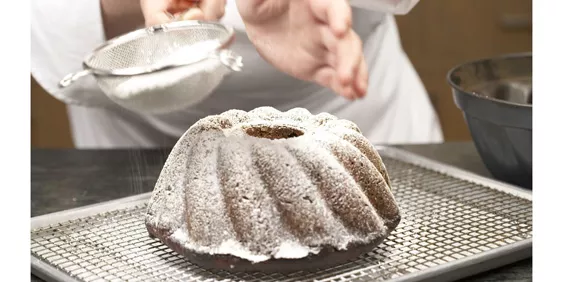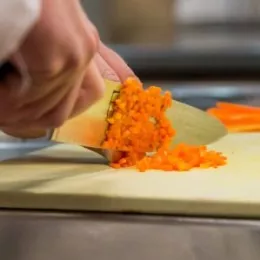A recipe request by one of our Facebook fans after a photo was posted of our wonderful Pastry Chef-Instructor Kathy Sadler making this recipe on Kugelhopf Day!

KUGELHOPF
AUSTRIAN BOWL CAKE
Recipe by International Culinary Center
Used in Professional Pastry Arts and Art of International Bread Baking programs.
Yield: 1 kugelhopf
For the Sponge
150 g all-purpose flour
30 g yeast
150 mL warm milk
For the Dough
140 g butter
140 g powdered sugar
1 t salt
Zest of 1 lemon
1 T vanilla sugar
2 eggs
1 egg yolk
250 g bread flour
Pinch of nutmeg
50 g warm milk
150 g raisins, plumped in water and drained
15 to 20 whole blanched almonds
Powdered sugar, for finishing
For the Sponge
1. Prepare sponge with the all-purpose flour, yeast, and the 150 mL of milk. Set aside and allow the sponge to double.
2. Prepare the dough: Cream together the butter, powdered sugar, salt, lemon zest, and vanilla sugar until light and fluffy.
3. Add the eggs one at a time, and allow each to fully incorporate before adding the next.
4. Add the sponge to the creamed butter mixture.
5. Add the bread flour, nutmeg, and 50 g of milk to the mixture.
6. Mix/knead to develop gluten, scraping the sides of the bowl often.
7. Add the raisins and mix just to combine.
8. First proof: Place in oiled bowl, cover, and proof 30 to 40 minutes or until doubled in size.
9. Prepare the mold: Put almonds in the bottom of a buttered kugelhopf mold.
10. Turn dough when proofed, and place in prepared mold. Final proof and allow the dough to ferment in the mold. The dough should rise to ½ inch below the top edge of the mold.
12. Egg wash.
13. Bake the kugelhopf at 350°F (176°C) for 35 to 40 minutes, or until dark brown.
14. Unmold immediately after baking onto a cooling rack to prevent it from becoming soggy.
For the Finish
Lightly dust with powdered sugar.
Special Instructions
• To save time, cream the butter and sugar while the sponge is rising.
• Once the sponge and bread flour have been added, it will take several minutes to build up the gluten.
• The dough will remain very loose but gluten structure should be apparent.
• Add the raisins last to avoid breaking them apart and discoloring the dough.
• Be careful unmolding the bread; it will be very fragile while hot.
This blog post was originally published by the International Culinary Center (ICC), founded as The French Culinary Institute (FCI). In 2020, ICE and ICC came together on one strong and dynamic national platform at ICE's campuses in New York City and Los Angeles. Explore your pastry education where the legacy lives on.



